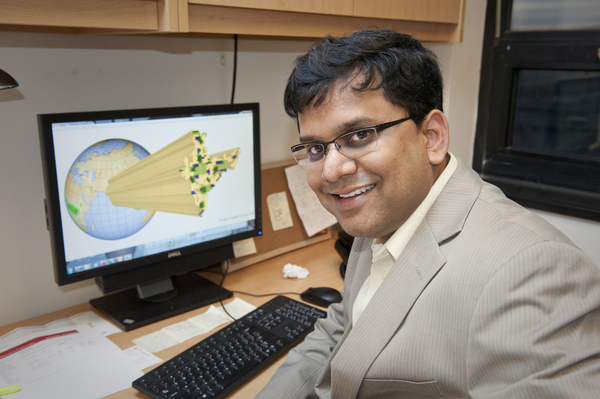3Qs: With Sandy, climate change ‘loads the dice’

Though it’s difficult to tie a specific storm like Hurricane Sandy to the phenomenon of climate change, Auroop Ganguly, an associate professor of civil and environmental engineering at Northeastern, says “It is becoming increasingly harder to ignore the empirical evidence” that human-influenced climate change affects the weather.
What role does climate change play in the development of superstorms like Hurricane Sandy, which battered much of the East Coast with high winds and floodwaters?
Climate change loads the dice. However, the scientific community has usually been extra cautious before attributing any one weather extreme event to climate change. This is especially true for extremes such as hurricanes where the link with climate change is less well understood.
The current state of climate science allows the attribution of certain types of weather extremes to climate change, but primarily in terms of average statistics. Thus, we can say with some confidence that heat waves have been intensifying, and will continue to do so at continental to global scales. There have been recent developments in our ability to attribute precipitation extremes to climate change. We are also getting better at attributions of more localized extremes. In fact, one British group was able to attribute flood risks for autumn of 2000 in England and Wales to human-induced emissions. However, hurricanes are much harder, and one extreme event remains difficult to attribute.
That being said, it is becoming increasingly harder to ignore the empirical evidence. Based on current understanding, the more intense hurricanes are expected to intensify further on an average. What we are seeing now certainly does not disagree with our current understanding of the implications of human-induced global warming.
Should storms like Sandy, which arrive late in hurricane season and pack a powerful punch, be considered something of a new normal? And if so, how must those in areas likely to be impacted change how they think about these storms?
Certainly there is a need to increase preparedness levels for more intense hurricanes and perhaps extended hurricane seasons. This is a perfect example where the climate science may not yet be as precise as we would like, but important preparedness decisions still need to be made with some urgency. This is also an example where delayed decisions may cost human lives, destroy critical infrastructures and damage economies. The importance of adaptation and preparedness in this context cannot be overstated.
Intensifying hurricanes, rising sea levels and growing storm surges, in conjunction with growth of population and infrastructures in regions at risk, point to the need for sustainable urban and coastal planning, and includes the need to develop greater resilience to natural hazards. Advances in weather and climate sciences, as well as early-warning systems, can help save lives and preserve infrastructures. Community and infrastructural resilience, as well as emergency preparedness, are critical and may prevent hazards from becoming disasters. Measures ranging from effective design strategies to public education and evacuation planning, among others, can help.
We may not be able to attribute single storms to climate change or pinpoint the exact locations of landfalls in advance, but we can still develop new adaptation and preparedness strategies. As our science improves, such strategies may be fine-tuned, but mounting evidence suggests that inaction may turn out to be costlier than action.
How can scientists tell if extreme weather incidents like Sandy are one-off storms or if they are part of a larger shift in climate?
Attributing extreme weather to climate change rather than natural climate variability requires meticulous analysis of data, typically from both observations and model simulations. The latter may include global and regional climate models, as well as more localized numerical models to simulate weather extremes. The statistical techniques are relatively well developed in certain situations but need further development for other conditions. The science of attribution has been steadily improving, but what has remained constant is the need for detailed and meticulous shifting through data and running of models to delineate possible causality.
The type of “fingerprints” that climate scientists look for are, for example, co-occurrence of observed patterns and events that are statistically robust; precedence structures suggestive of cause-effect relations; and significant changes in projections from multiple model runs. The meticulous studies leading to delineation of causality or attributions can take a while and would typically require gathering of relatively large volumes of observed data and generation of model simulations. While we are gradually getting better, there is still some way to go before we can confidently make more precise attributions.





